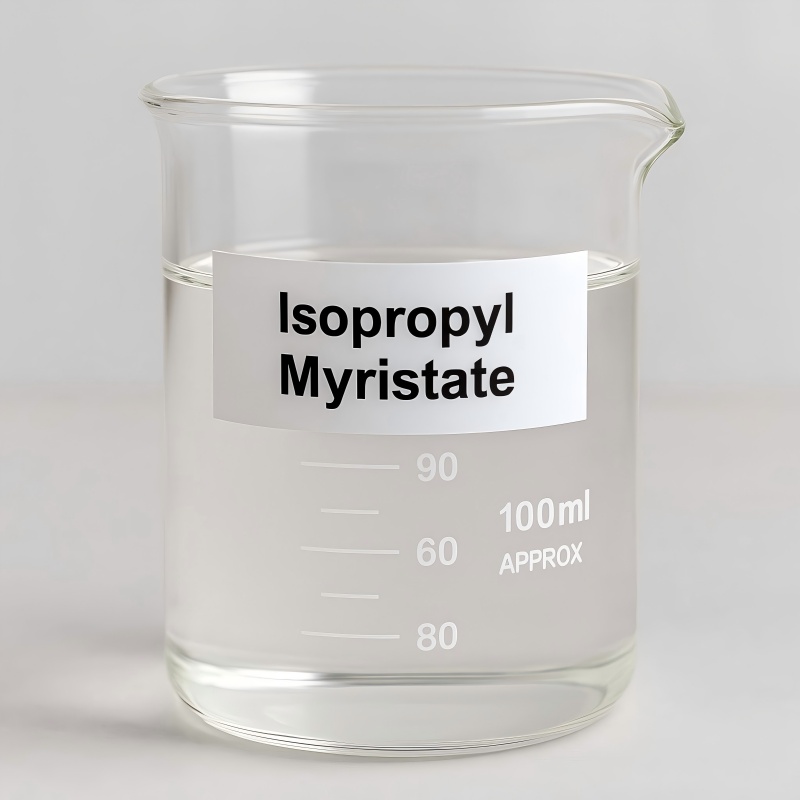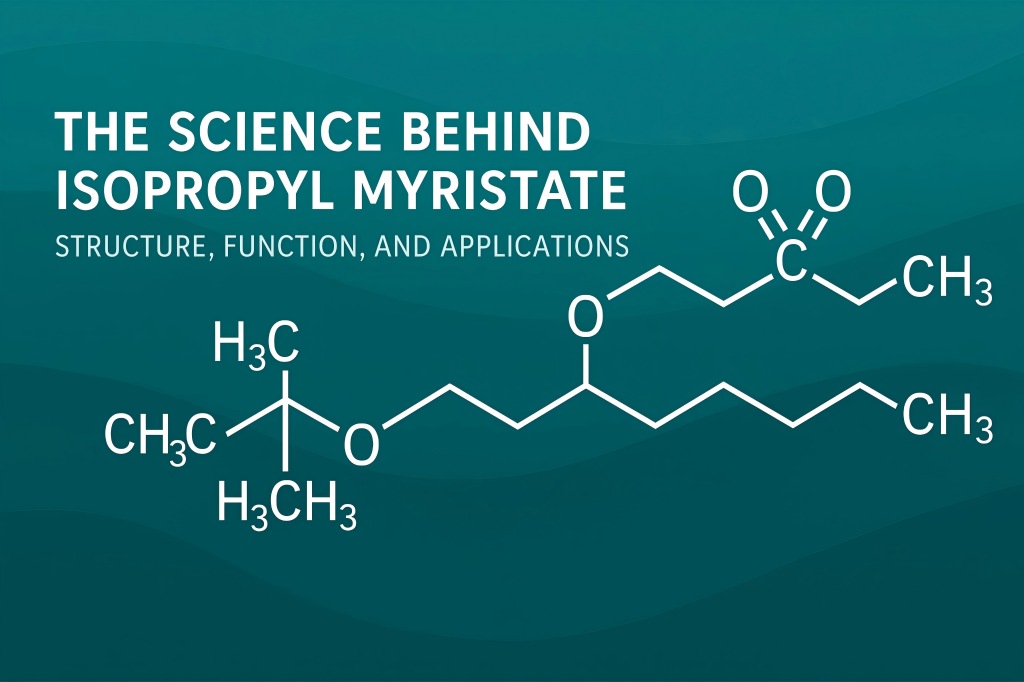Isopropyl Myristate (IPM) is an ester compound that plays a vital role in modern formulation science. Its widespread use in skincare, pharmaceuticals, and industrial applications is due to its unique molecular characteristics, multifunctional properties, and high compatibility with other ingredients.
This article provides an in-depth look at the science behind IPM—its structure, functionality, cross-industry relevance, and regulatory standing in global markets.
Understanding the Molecular Structure of Isopropyl Myristate
Isopropyl Myristate is the ester formed by the reaction of isopropyl alcohol with myristic acid, a 14-carbon saturated fatty acid found in natural fats and oils, particularly coconut oil and palm kernel oil. The resulting molecule, C₁₇H₃₄O₂, is a clear, colorless, low-viscosity liquid with a mild odor and excellent spreadability. It is hydrophobic, oil-soluble, and has a molecular weight of 270.45 g/mol.
What sets IPM apart is its dual chemical nature:
- The isopropyl group contributes to its lightweight, non-greasy character and volatility.
- The fatty acid chain allows for excellent skin affinity, contributing to its emollient and penetration-enhancing effects.
This molecular configuration makes IPM not only a solvent and carrier but also a texture enhancer. Its behavior in emulsions and topical solutions stems from its compatibility with lipophilic components and its ability to interact with the lipid layers of the skin.
Key Functional Properties of Isopropyl Myristate in Formulations
The formulation utility of IPM lies in its ability to fulfill several roles simultaneously. Whether in skincare, haircare, or pharmaceuticals, its functional diversity makes it indispensable.
Emollient
IPM acts as a skin-conditioning agent, forming a soft, smooth film on the skin. It softens and soothes without leaving behind a sticky or greasy feel, ideal for light moisturizers, after-sun products, and grooming aids.
Solvent
IPM has excellent solubility for lipophilic active ingredients, such as fat-soluble vitamins, essential oils, or pharmaceutical actives. It helps in the uniform dispersion of actives and enhances formulation stability.
Penetration Enhancer
Due to its ability to disrupt the skin’s outer lipid barrier (stratum corneum), IPM facilitates transdermal and dermal delivery of active compounds. This makes it highly valuable in drug delivery systems, particularly in topical and transdermal formulations.
Spreading Agent
Its low viscosity and light skin feel allow IPM to enhance spreadability. It reduces drag during application, improving the sensory profile of creams and lotions.
Non-occlusive Carrier
Unlike mineral oils or heavy silicones, IPM doesn’t block pores. It delivers actives into the skin without forming a heavy or occlusive layer, making it suitable even for formulations targeting oily or acne-prone skin.
These functional traits explain why IPM is commonly used in concentrations ranging from 1% to 20%, depending on the formulation objective.

Why Isopropyl Myristate Is a Versatile Ingredient Across Industries
The true value of IPM is reflected in its adaptability. It is not limited to beauty and skincare; its cross-industry relevance is rooted in its chemical compatibility, safety, and efficacy.
Cosmetics and Personal Care
In lotions, sunscreens, serums, cleansers, and makeup removers, IPM contributes to better feel, improved texture, and enhanced delivery of actives. It is especially favored in lightweight, fast-absorbing products that demand elegance and functionality.
Pharmaceuticals
IPM is frequently used as a vehicle in topical pharmaceutical formulations, including corticosteroid creams, antifungals, analgesic balms, and transdermal patches. Its ability to facilitate skin penetration boosts bioavailability of drugs administered through the skin.
Fragrance and Perfumes
As a solvent and fixative, IPM helps in the dispersion of aromatic molecules and enhances fragrance performance on the skin. It also improves volatility in perfume and deodorant formulations.
Veterinary Products
IPM’s absorption-enhancing and emollient properties make it ideal for flea and tick treatments, medicated ointments, and grooming products for animals.
Industrial Uses
In specialty chemicals, IPM is used in textile treatments, plasticizers, and as a dispersing agent in non-aqueous systems. Its solvent properties support industrial coating and lubrication applications.
This breadth of application stems from IPM’s excellent balance of function, safety, and performance, providing manufacturers with a dependable and adaptable ingredient.
Performance Advantages of Isopropyl Myristate in Cosmetics and Topicals
In the crowded world of cosmetic and personal care ingredients, IPM continues to stand out for several performance-enhancing characteristics:
Quick Absorption and Lightweight Feel
IPM provides a dry-touch finish that consumers associate with high-end skincare products. It disappears quickly upon application, carrying active ingredients without leaving residue.
Enhances the Efficacy of Actives
By improving dermal penetration, IPM increases the effectiveness of actives such as retinoids, salicylic acid, niacinamide, and more. This makes it popular in performance-driven skincare categories like anti-aging, acne treatment, and spot correction.
Improves Texture and Sensory Appeal
It reduces the greasy feel associated with some emollients and oils. Formulations containing IPM glide effortlessly, improving consumer satisfaction and product usability.
Boosts Stability in Emulsions
Due to its lipophilic nature, IPM helps stabilize oil phases and enhances emulsion compatibility, especially in water-in-oil systems. It is used to achieve creamy, uniform textures in skincare and pharmaceutical emulsions.
Suitable for Sensitive Skin (With Considerations)
IPM is typically non-irritating and non-sensitizing when used correctly, making it suitable for sensitive and reactive skin types. However, formulations should avoid excessive use (>20%) to minimize potential comedogenicity or irritation.
Whether in daily moisturizers or therapeutic salves, IPM offers functional superiority across all product types.
Environmental Profile and Biodegradability of Isopropyl Myristate
With the rise of clean beauty and sustainable chemistry, the ecological profile of ingredients is under increasing scrutiny. Fortunately, Isopropyl Myristate aligns well with environmental considerations.
Readily Biodegradable
According to OECD guidelines, IPM is readily biodegradable, breaking down into its constituent parts (isopropyl alcohol and myristic acid) under aerobic conditions.
Low Bioaccumulation
Compared to persistent silicones like cyclopentasiloxane (D5), IPM shows minimal bioaccumulative behavior, posing less risk to aquatic ecosystems.
Sourced from Renewable Feedstocks
Myristic acid, a key component of IPM, is derived from natural oils such as coconut and palm kernel oil. When responsibly sourced, this supports renewable ingredient claims and lowers environmental impact.
VOC and Compliance Considerations
IPM is compliant with most VOC regulations, although formulators in aerosol products or spray systems should still verify local standards.
With increasing restrictions on non-biodegradable silicones in Europe and growing demand for greener formulations globally, IPM is becoming a preferred alternative.
Safety and Regulatory Status of Isopropyl Myristate Globally
Isopropyl Myristate has a well-documented safety record across decades of use and is approved for topical application in personal care and pharmaceutical products across the globe.
United States (FDA & CIR)
The FDA permits IPM in over-the-counter (OTC) topical drug products and cosmetics. The Cosmetic Ingredient Review (CIR) panel classifies IPM as safe for use as intended, with no significant safety concerns at recommended concentrations.
European Union (REACH & Cosmetics Regulation)
IPM is included in the Cosmetic Ingredients Database (CosIng) and is not restricted under the EU’s Cosmetic Regulation (EC No. 1223/2009). It is also not classified as hazardous under REACH.
China, Japan, Korea
In Asia-Pacific, IPM is listed in China’s IECIC (Inventory of Existing Cosmetic Ingredients) and Japan’s JSCI (Japanese Standards of Cosmetic Ingredients). It is broadly used in K-Beauty and J-Beauty formulations.
Safety Profile
- Non-mutagenic
- Non-carcinogenic
- Non-sensitizing at typical use levels
- Adverse effects are rare and generally limited to high concentrations or prolonged exposure in sensitive individuals.
Formulators are advised to conduct patch testing and remain within 1–15% inclusion range in leave-on products to minimize any potential for irritation.

